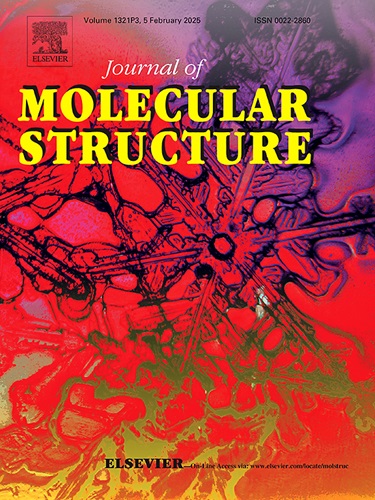具有白光发射特性的新型零维锑基有机-无机材料的制备及晶体学表征
IF 4
2区 化学
Q2 CHEMISTRY, PHYSICAL
引用次数: 0
摘要
基于氯化锑(III)的零维材料作为宽带发射体引起了广泛的关注。这些0D化合物具有结构适应性,可以采用八面体或方锥体的几何形状,这显著影响了它们的发射性能。在此背景下,我们合成了一种新型的有机-无机杂化材料(Qx-H)₄Sb₂Cl₁₀(Qx-H⁺:喹草铝),并通过100 K下的x射线衍射、Hirshfeld表面分析、振动光谱和光学研究对其进行了全面表征。该化合物在三斜P1¯空间群中结晶,其晶体结构显示固态中不寻常的Sb···Cl相互作用,导致个体[SbCl₅]²⁻多面体转化为离散的双核[Sb₂Cl₁₀]⁴⁻。(Qx-H)₄Sb₂Cl₁₀的三维(3D)超分子框架是通过N-H··Cl氢键和π··π堆叠相互作用等多种二级相互作用稳定的。此外,采用二维指纹图谱和Hirshfeld表面分析来确定控制晶体堆积的关键分子间相互作用。利用拉曼光谱和红外光谱进行了振动分析。通过紫外可见光谱对其光学性质进行了研究,发现其带隙为3.99 eV。在CAM-B3LYP/Lanl2dz水平上进行密度泛函理论(DFT)计算,以获得对电子结构的理论见解,特别是吸收光谱和HOMO-LUMO间隙。此外,研究了非线性光学性质,以评估偶极矩、线性极化率和二次超极化率。值得注意的是,该化合物在375 nm激发时表现出明显的白光发射。相关色温(CCT)在6623 K测量,表明“冷”白光发射。本文章由计算机程序翻译,如有差异,请以英文原文为准。

Facile preparation and crystallographic characterization of a new zero-dimensional antimony (III)-based organic-inorganic material with white light emission properties
Zero-dimensional materials based on antimony(III) chloride have attracted considerable attention as broadband emitters. These 0D compounds exhibit structural adaptability, adopting either octahedral or square-pyramidal geometries, which significantly influence their emissive properties. In this context, a novel organic-inorganic hybrid material, (Qx-H)₄Sb₂Cl₁₀ (Qx-H⁺: quinoxalinium), was synthesized and thoroughly characterized using X-ray diffraction at 100 K, Hirshfeld surface analysis, vibrational spectroscopy, and optical studies. The compound crystallizes in the triclinic P space group, and its crystal structure reveals unusual Sb···Cl interactions in the solid state, leading to the conversion of individual [SbCl₅]²⁻ polyhedra into discrete binuclear [Sb₂Cl₁₀]⁴⁻ units. The three-dimensional (3D) supramolecular framework of (Qx-H)₄Sb₂Cl₁₀ is stabilized by multiple secondary interactions, including N–H···Cl hydrogen bonds and π···π stacking interactions. Additionally, 2D fingerprint plots and Hirshfeld surface analyses were employed to identify the key intermolecular interactions governing the crystal packing. A vibrational analysis was carried out using Raman and infrared spectroscopy. The optical properties were investigated by UV–Visible spectroscopy, revealing a band gap of 3.99 eV. Density Functional Theory (DFT) calculations at the CAM-B3LYP/Lanl2dz level were performed to gain theoretical insights into the electronic structure, particularly the absorption spectrum and the HOMO–LUMO gap. Furthermore, the nonlinear optical (NLO) properties were examined to evaluate the dipole moment, linear polarizability, and second hyperpolarizability. Notably, the compound exhibits significant white light emission upon excitation at 375 nm. The correlated color temperature (CCT) was measured at 6623 K, indicative of a "cool" white light emission.
求助全文
通过发布文献求助,成功后即可免费获取论文全文。
去求助
来源期刊

Journal of Molecular Structure
化学-物理化学
CiteScore
7.10
自引率
15.80%
发文量
2384
审稿时长
45 days
期刊介绍:
The Journal of Molecular Structure is dedicated to the publication of full-length articles and review papers, providing important new structural information on all types of chemical species including:
• Stable and unstable molecules in all types of environments (vapour, molecular beam, liquid, solution, liquid crystal, solid state, matrix-isolated, surface-absorbed etc.)
• Chemical intermediates
• Molecules in excited states
• Biological molecules
• Polymers.
The methods used may include any combination of spectroscopic and non-spectroscopic techniques, for example:
• Infrared spectroscopy (mid, far, near)
• Raman spectroscopy and non-linear Raman methods (CARS, etc.)
• Electronic absorption spectroscopy
• Optical rotatory dispersion and circular dichroism
• Fluorescence and phosphorescence techniques
• Electron spectroscopies (PES, XPS), EXAFS, etc.
• Microwave spectroscopy
• Electron diffraction
• NMR and ESR spectroscopies
• Mössbauer spectroscopy
• X-ray crystallography
• Charge Density Analyses
• Computational Studies (supplementing experimental methods)
We encourage publications combining theoretical and experimental approaches. The structural insights gained by the studies should be correlated with the properties, activity and/ or reactivity of the molecule under investigation and the relevance of this molecule and its implications should be discussed.
 求助内容:
求助内容: 应助结果提醒方式:
应助结果提醒方式:


